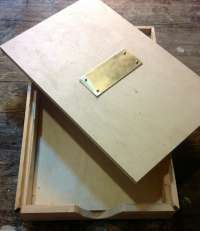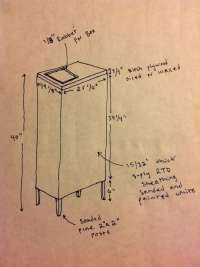The Great Wall Archive presents many potential narratives through the collection and exhibition of an excess of specific and seemingly arbitrary information. Its conception was spurred by a curiosity in the ways we communicate with one another, specifically, the ways we communicate and understand value. We want to know what value looks like to other people and why. Currently, we are exploring this question through conversations with the BTTAA. Although much of this was conjecture initially, these conversations became the process of identifying entities who's value is culturally indisputable. This list of valued commodities grew to include tourist destinations (historical monuments, theme parks, entire countries), leisure activities, antiquities and education.
External value systems make it easy for us to accept the importance of things without contemplating their personal and internal relevance. In these circumstances, art works have the freedom to act as tourist destinations do: stories, photographs, postcards and other documents validate the importance of the destination. The Great Wall Archive utilizes the viewers' passivity in order to monumentalize the great wall restaurants. Through the use of quality materials, the archival medium and systematically organized information, the viewer is convinced of the archive's validity.
Using The Great Wall restaurants as a means to explore some of these ideas is as logical as it is absurd. It may initially appear ostensibly trivial, but the stability of its content implies deeper and more complex concepts. The Great Wall Archive is able to communicate multiple, often varying ideas that shift and change through investigation. As an archive, the specific information and content proposes possibilities instead of making conclusive statements. The Great Wall Archive is an attempt to challenge the viewer to question their daily value systems.
// Details //
The archive is to be developed through four equally necessary steps: research, acquisition, production and presentation. During this research, we chronicled twenty-nine Great Wall Chinese Restaurants, gathering their basic information ( address, phone number(s) and hours ) and their reviews on Yelp. These addresses were then plotted on a map of New York City and grouped into what we call "tours." These tours are the action of visiting, taking a menu from the restaurant, a photo of the front of the building, completing our log and cataloguing the physical location with an edition number ( x / 29 ), adhered to the sidewalk in front of the restaurant.
We are looking to dedicate a room to the manifestation of this archiving of New York City's Great Wall Chinese Restaurants. The installation will include a series of boxes, each the same in size and fashion, fabricated specifically for the archive. Each of the twenty-nine boxes will house the information acquired from it's corresponding Great Wall Chinese restaurant: a page with the name of the restaurant, it's address, hours and phone number( s ), the log we complete upon visiting, restaurant menu, yelp reviews and our developed photos taken of the front of the restaurant This information is transcribed via typewriter to separate, 8.5" x 14" identical pages. This transcription process evades any trace of authorship or singularity. The back of each page will be stamped with a custom stamp, bearing the BTTAA's insignia and placed face-up in a uniform order.
We are looking to get one-half inch poplar boards cut and fashioned into boxes, 9 5/8" x 15 1/8" x 2 1/2" in dimensions with sliding lids. On each lid will be bronze plaques stamped with the name of each restaurant and its edition. Each box will sit on uniform tables. The tables will be attractive, but only in order to draw further attention to the boxes that they support and elevate. The tables and boxes will be neatly and functionally organized around the installation room in order to allow for easy access to each box.
One wall of the installation room will brandish a large mural of the BTTAA insignia, which will be projected and traced onto the wall. On the adjacent wall there will be two copies of 40" x 9.5" typewritten master-lists of all of the great wall restaurants. On one copy, each restaurant is crossed out with the date visited written beside it and the other is kept clean. Next to the master lists will be a large, hand-traced map of New York City, with each of the restaurants plotted at their locations. Across from this wall will host ten hand-traced maps, each referring to the tours, which will be available to visitors as off-set print takeaways
( souvenirs ). The maps, master-lists, boxes, contents of the box and the edition number adhered to the sidewalk all serve as source materials which can be entered at different points, yet all reinforce one another.
The Great Wall Archive presents many potential narratives through the collection and exhibition of an excess of specific and seemingly arbitrary information. Its conception was spurred by a curiosity in the ways we communicate with one another, specifically, the ways we communicate and understand value. We want to know what value looks like to other people and why. Currently, we are exploring this question through conversations with the BTTAA. Although much of this was conjecture initially, these conversations became the process of identifying entities who's value is culturally indisputable. This list of valued commodities grew to include tourist destinations (historical monuments, theme parks, entire countries), leisure activities, antiquities and education.
External value systems make it easy for us to accept the importance of things without contemplating their personal and internal relevance. In these circumstances, art works have the freedom to act as tourist destinations do: stories, photographs, postcards and other documents validate the importance of the destination. The Great Wall Archive utilizes the viewers' passivity in order to monumentalize the great wall restaurants. Through the use of quality materials, the archival medium and systematically organized information, the viewer is convinced of the archive's validity.
Using The Great Wall restaurants as a means to explore some of these ideas is as logical as it is absurd. It may initially appear ostensibly trivial, but the stability of its content implies deeper and more complex concepts. The Great Wall Archive is able to communicate multiple, often varying ideas that shift and change through investigation. As an archive, the specific information and content proposes possibilities instead of making conclusive statements. The Great Wall Archive is an attempt to challenge the viewer to question their daily value systems.
// Details //
The archive is to be developed through four equally necessary steps: research, acquisition, production and presentation. During this research, we chronicled twenty-nine Great Wall Chinese Restaurants, gathering their basic information ( address, phone number(s) and hours ) and their reviews on Yelp. These addresses were then plotted on a map of New York City and grouped into what we call "tours." These tours are the action of visiting, taking a menu from the restaurant, a photo of the front of the building, completing our log and cataloguing the physical location with an edition number ( x / 29 ), adhered to the sidewalk in front of the restaurant.
We are looking to dedicate a room to the manifestation of this archiving of New York City's Great Wall Chinese Restaurants. The installation will include a series of boxes, each the same in size and fashion, fabricated specifically for the archive. Each of the twenty-nine boxes will house the information acquired from it's corresponding Great Wall Chinese restaurant: a page with the name of the restaurant, it's address, hours and phone number( s ), the log we complete upon visiting, restaurant menu, yelp reviews and our developed photos taken of the front of the restaurant This information is transcribed via typewriter to separate, 8.5" x 14" identical pages. This transcription process evades any trace of authorship or singularity. The back of each page will be stamped with a custom stamp, bearing the BTTAA's insignia and placed face-up in a uniform order.
We are looking to get one-half inch poplar boards cut and fashioned into boxes, 9 5/8" x 15 1/8" x 2 1/2" in dimensions with sliding lids. On each lid will be bronze plaques stamped with the name of each restaurant and its edition. Each box will sit on uniform tables. The tables will be attractive, but only in order to draw further attention to the boxes that they support and elevate. The tables and boxes will be neatly and functionally organized around the installation room in order to allow for easy access to each box.
One wall of the installation room will brandish a large mural of the BTTAA insignia, which will be projected and traced onto the wall. On the adjacent wall there will be two copies of 40" x 9.5" typewritten master-lists of all of the great wall restaurants. On one copy, each restaurant is crossed out with the date visited written beside it and the other is kept clean. Next to the master lists will be a large, hand-traced map of New York City, with each of the restaurants plotted at their locations. Across from this wall will host ten hand-traced maps, each referring to the tours, which will be available to visitors as off-set print takeaways
( souvenirs ). The maps, master-lists, boxes, contents of the box and the edition number adhered to the sidewalk all serve as source materials which can be entered at different points, yet all reinforce one another.


